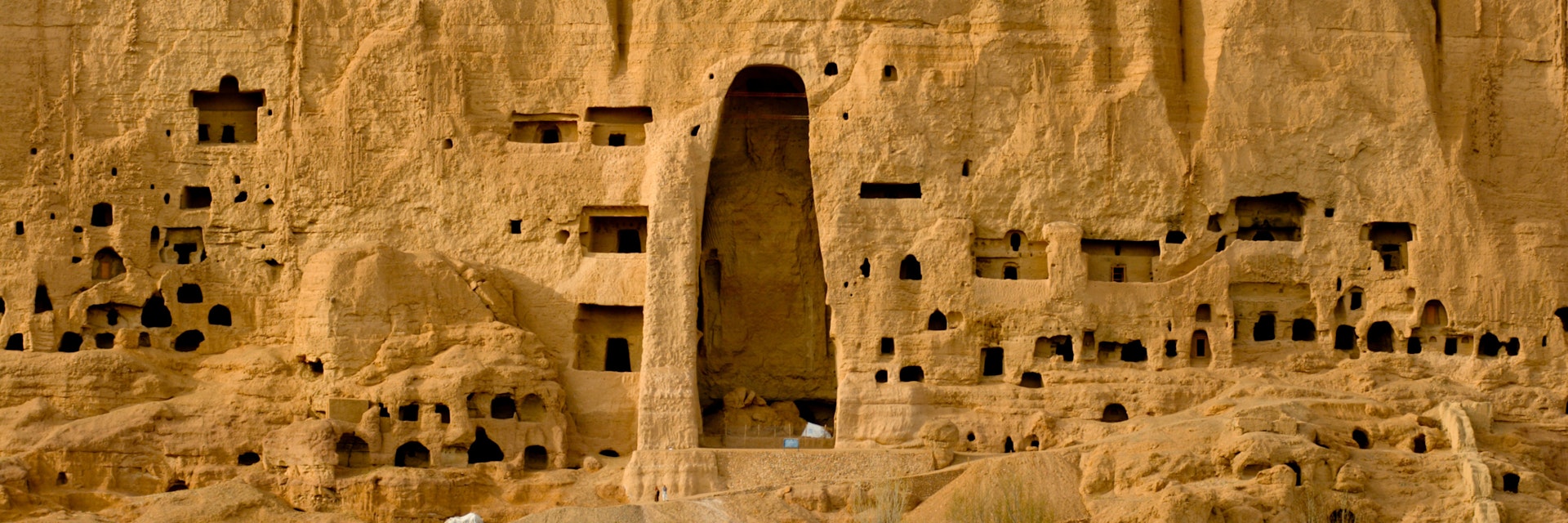The empty niches of the Buddha statues dominate the Bamiyan valley. Carved in the 6th century, the two statues, standing 38m and 55m respectively, were the tallest standing statues of Buddha ever made. Now gone, the emptiness of the spaces the statues have left behind nevertheless inspire awe and quiet contemplation in equal measure. The bases of the niches are fenced off and although it is quite possible to view them for free from some distance, a ticket from the office of the Director of Information and Culture (In front of Large Buddha niche) allows further access to the site.
Next to the director's office is a large shed containing the salvaged remains of the Large Buddha, which give an insight into the construction of the statues. They weren't simply carved out of the sandstone cliffs - rough figures were instead hewn from the rock, which was then covered in mud and straw to create the intricate folds of the robes, before being plastered and painted. The Large Buddha was painted with red robes, while the Small Buddha was clothed in red. Their faces were covered in gilded masks, although all traces of these disappeared in antiquity. The Chinese monk Xuan Zang visited Bamiyan at the height of its glory in the 7th century, writing of the statues that 'the golden hues sparkle on every side, and its precious ornaments dazzle the eye by their brightness'. As a devout pilgrim, Xuan Zang may have looked back on the statues' ultimate destruction as reflecting a central teaching of the Buddha: nothing is permanent and everything changes.
The remaining chunks of statue are a small fraction of the total - the Taliban sold much of what was not simply destroyed to Pakistani antique dealers in Peshawar.
The view from the base of the niche to its ceiling is dizzying. The ceiling and walls were once covered with frescoes, using symbolism borrowed from Greek, Indian and Sassanid (Persian) art. The fusion of these traditions, gave the Buddhist art of Bamiyan its vitality, which would later spread to India and China.
The cliffs surrounding each Buddha are honeycombed with monastic cells and grottoes, and your entrance ticket allows a guided tour. When we visited, the guides were enthusiastic but didn't have much English (or information), although a proper training programme is now reportedly in place. When exploring the cells and passages, good shoes are recommended, as well as a torch. Hard hats are provided - less for the fear of falling rocks than the inevitability of banging your head on the low ceilings.
The Large Buddha's grottoes are relatively few in number. You enter them by climbing almost around the back of the Buddha, cutting up some way to the left. The path here is marked with white rocks to show recent demining. The cells were originally decorated with frescoes displaying Buddhas and Bodhisattvas, all now lost in this section. In total, it is estimated that around 85% of the paintings disappeared during the war, through neglect, theft or deliberate destruction.
As you follow the passages you eventually emerge above the head of the Large Buddha. The views are amazing, unless you suffer from vertigo. The top of the niche has been braced with scaffolding to prevent subsidence. As with the cells, the ceiling was once elaborately painted.
The Small Buddha niche stands 500m to the east. The intervening section of cliff is honeycombed with cells, sanctuaries and passages tunnelled into the rock. Now long gone, a series of stupas and monasteries at the foot of the cliff further served the Buddhist complex. Xuan Zang noted ten convents and over a thousand priests and at its peak, Bamiyan is thought to have contained around 50 temples. Halfway between the two Buddhas is a smaller third niche, high on the cliff, which would have held a free-standing Buddha statue. In the aftermath of the Taliban's ouster, many of these caves were occupied by Hazara IDPs.
The grottoes of the Small Buddha are far more extensive and rewarding than those at the Large Buddha, in part because this site nearly a century older. You enter via stairs at the base of the niche - these stairs encircle the niche, allowing the faithful to circumambulate the Buddha, an important ritual. Although almost all of the frescoes have been lost, a few glimpses remain in a couple of places. The so-called assembly hall on the west side has bright blue and maroon fragments of a huge lotus on its cupola, surrounded by a red band decorated with delicate white flowers. It's just enough to give a tantalising idea of how the whole might have looked. Near this hall is a vestibule looking out to the valley, which still retains its original facade, with the stone carved to resemble jutting wood beams.
The grottoes continue on the east side of the niche, with many rooms containing carved lantern-roof ceilings and wall niches for Buddha statues.
Bamiyan's heyday as a Buddhist pilgrimage site barely lasted a handful of centuries. After a brief period of coexistence with its expanding Muslim neighbours, it slipped into terminal decline around the 10th century, when many statues and temples were destroyed. Memories of the Buddhist past faded and locals began to suppose that the statues were of pagan kings. Amazingly, Genghis Khan left them standing - about the only thing he did leave intact in Bamiyan. Greater damage was done in the 17th century when the Mughal emperor Aurangzeb smashed their faces. A hundred years later the legs of the Large Buddha were cut off by the Persian Nadir Shah.
During the civil war, the niches and caves were often used as ammunition dumps, with some soldiers occasionally using the statues for casual target practice. The final, terrible, indignity came with their complete demolition by the Taliban in March 2001, leaving behind an indelible testament to Afghanistan's many cultural losses in recent wars.

